Files in this item
Trends in alluvial channel geometry and streamflow : an investigation of patterns and controls
Item metadata
| dc.contributor.advisor | Singer, Michael B. | |
| dc.contributor.author | Slater, Louise J. | |
| dc.coverage.spatial | 245 | en_US |
| dc.date.accessioned | 2015-07-06T14:30:34Z | |
| dc.date.available | 2015-07-06T14:30:34Z | |
| dc.date.issued | 2015-06 | |
| dc.identifier | uk.bl.ethos.655447 | |
| dc.identifier.uri | https://hdl.handle.net/10023/6913 | |
| dc.description.abstract | Alluvial river channels are self-formed by the sediment-laden flow that is supplied to them from upstream and the interactions between this flow and the materials forming the channel bed and banks. Thus, any changes in the volumes of solid and liquid discharge or the resistance of the boundary materials can produce adjustments in the form of river channels over time. These shifts may increase or decrease the capacity of a channel to contain flood flows. However, despite a wealth of studies on the average geometry of river channels across different scales and climatic regimes, there has not yet been a systematic assessment of the rates and controls of trends in channel form. Using a combination of USGS data, including manual field measurements and mean daily streamflow data at hundreds of stream gages, this work is the first attempt to quantify how trends in channel geometry develop over decadal timescales and how they contribute to shifts in flood hazard, in comparison with trends in streamflow. Findings reveal that two-thirds of all channel cross-sections studied exhibit significant trends in channel geometry. The majority of the investigated US river channels are eroding, with widening and deepening trends partially offset by decreases in average flow velocity. Rates of change are principally controlled by the channel size. Although large channels develop larger trends, changes are proportionally greater in small channels in percentage terms. A secondary major control is hydrology: rates of change in channel geometry are heightened by the variability and flashiness of flow regimes. Finally, results show that changing flood frequencies can only be accurately quantified when both hydrologic and geomorphic trends are accounted for, and that flood hazard is significantly increasing across the studied sites. These documented trends in channel geometry, hydraulics, and flood hazard have important implications for the management of alluvial channels, navigation, and riverside infrastructure. | en_US |
| dc.language.iso | en | en_US |
| dc.publisher | University of St Andrews | en |
| dc.rights | Creative Commons Attribution-NonCommercial-NoDerivatives 4.0 International | |
| dc.rights.uri | http://creativecommons.org/licenses/by-nc-nd/4.0/ | |
| dc.subject | Geomorphology | en_US |
| dc.subject | Hydrology | en_US |
| dc.subject | Streamflow | en_US |
| dc.subject | Floods | en_US |
| dc.subject | Trends | en_US |
| dc.subject | Time-series analysis | en_US |
| dc.subject | Channel geometry | en_US |
| dc.subject | Channel adjustment | en_US |
| dc.subject | USGS | en_US |
| dc.subject | Hydrometric data | en |
| dc.subject.lcc | GB564.S6 | |
| dc.subject.lcsh | River channels--United States | en_US |
| dc.subject.lcsh | Fluvial geomorphology--United States | en_US |
| dc.subject.lcsh | River channels | en_US |
| dc.subject.lcsh | Fluvial geomorphology | en_US |
| dc.subject.lcsh | Sedimentation and deposition | en_US |
| dc.title | Trends in alluvial channel geometry and streamflow : an investigation of patterns and controls | en_US |
| dc.type | Thesis | en_US |
| dc.contributor.sponsor | Natural Environment Research Council (NERC) | en_US |
| dc.type.qualificationlevel | Doctoral | en_US |
| dc.type.qualificationname | PhD Doctor of Philosophy | en_US |
| dc.publisher.institution | The University of St Andrews | en_US |
| dc.identifier.doi | https://doi.org/10.17630/10023-6913 |
This item appears in the following Collection(s)
Except where otherwise noted within the work, this item's licence for re-use is described as Creative Commons Attribution-NonCommercial-NoDerivatives 4.0 International
Items in the St Andrews Research Repository are protected by copyright, with all rights reserved, unless otherwise indicated.


